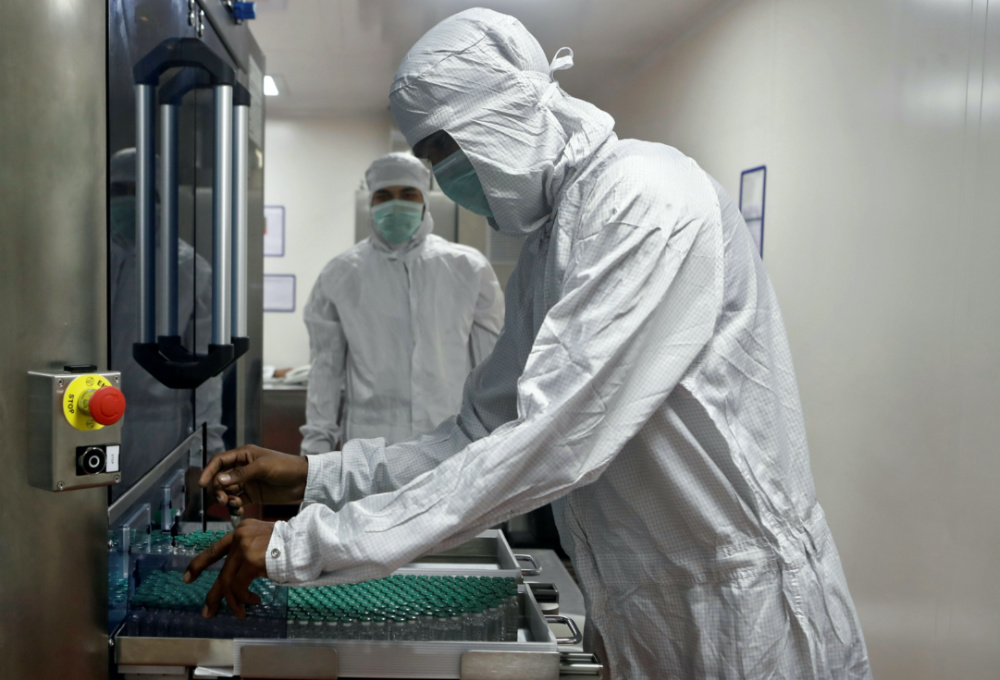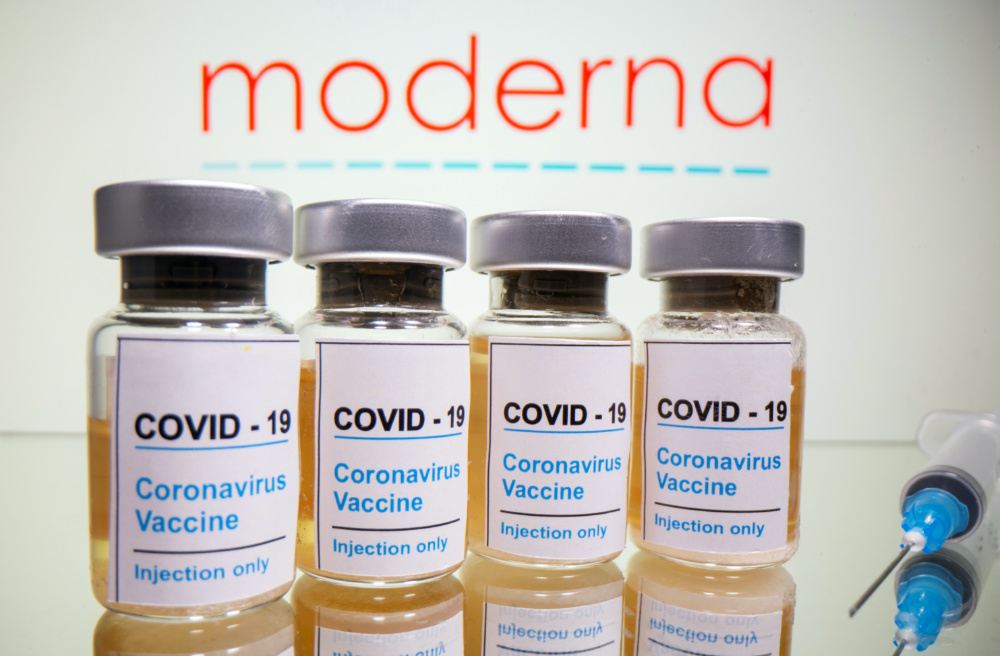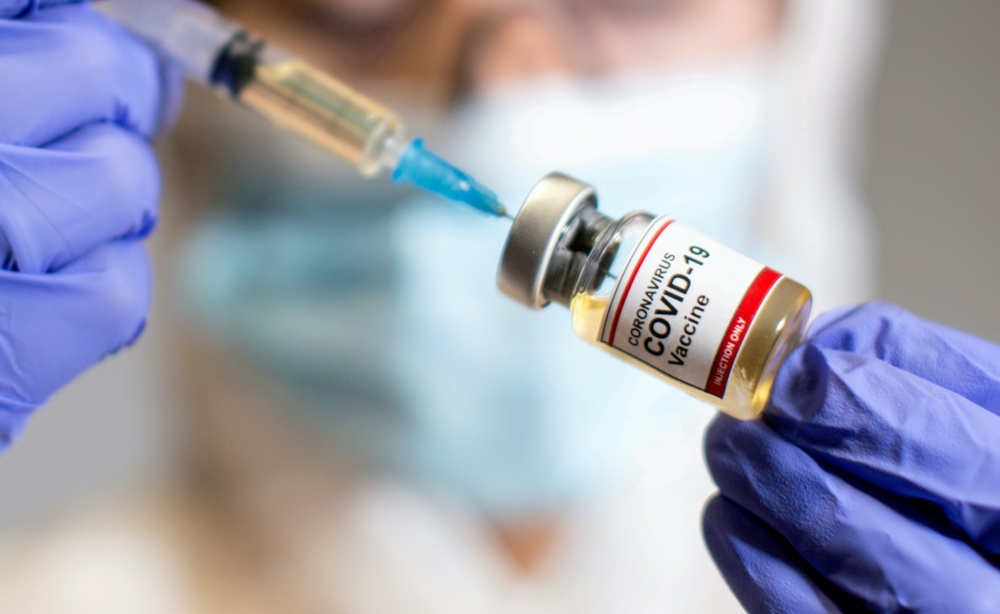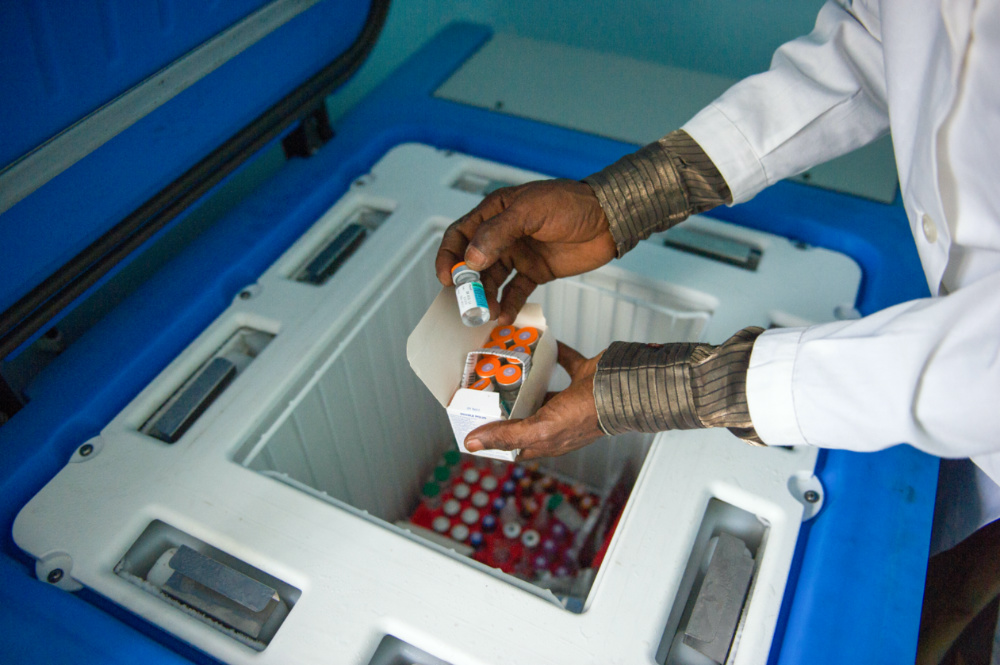
ANASTASIA MOLONEY, of Thomson Reuters Foundation, talks to the experts about what’s been learned from previous mass vaccination efforts around the world…
Rolling out COVID-19 vaccines to billions of people across the world means managing the most complex supply chains the world has ever seen.
But valuable lessons are there to be learned including from India where hundreds of millions of children are vaccinated against diseases every year and Sierra Leone where people received Ebola shots after the deadly disease outbreak in 2014.

An employee in personal protective equipment removes vials of AstraZeneca’s COVISHIELD, coronavirus disease (COVID-19) vaccine from a visual inspection machine inside a lab at Serum Institute of India, Pune, India, on 30th November, 2020.PICTUR: Reuters/Francis Mascarenhas/File photo
We asked public health experts and a community health worker who survived Ebola how they ensure vaccines reach those most in need.
Include women
Globally about 70 per cent of health workers are female, and women are often the ones looking after children and the elderly.
Public awareness campaigns must target women, as they influence if children and other family members get immunised.
Public awareness campaigns must target women, as they influence if children and other family members get immunised.
Female health workers across the world, including in Kenya, Ethiopia, and India, are already on the frontlines of promoting COVID-19 prevention messages and vaccines in their communities.
Ice factories
Several of the COVID-19 vaccines under development need an ultra-cold chain of minus 70 degrees Celsius (-94 F), while other vaccine contenders are stable at a temperature of minus 20 degrees Celsius (-4 F).
Ensuring cold-chain shipping, delivery, and storage infrastructure means partnering with ice factories, transport and logistics companies, and having generators in place so that ultra-cold storage facilities remain plugged during power cuts.
“A cold chain can become one of the biggest nightmares. One of the bottlenecks will be the equipment needed for ultra-cold chain,” said Barbara Saitta, a vaccine medical advisor for medical charity Medecins Sans Frontieres.

Vials with a sticker reading, “COVID-19 / Coronavirus vaccine / Injection only” and a medical syringe are seen in front of a displayed Moderna logo in this illustration taken on 31st October. PICTURE: Reuters/Dado Ruvic/Illustration
Ear to the ground – busting myths
Misinformation and pervasive myths about COVID-19 and vaccine programs in general undermine confidence and acceptance among communities, fuel mistrust, and in turn their success.
“It should not be assumed that if I take a vaccine to the population, the population will accept the vaccine,” said Somesh Kumar, senior director of technical leadership and innovation for Jhpiego, a global health non-profit and Johns Hopkins University affiliate.
One belief in parts of West Africa is that vaccines affect male sterility, while in Haiti one myth is that hospitals are testing a COVID vaccine on patients without their knowledge.
“In low-income countries, new vaccines are being seen as tested on them and them being guinea pigs,” said Robin Nandy, principal adviser and chief of immunisation at UNICEF.
The United Nations and medical non-profits are increasingly monitoring messages on social media about vaccines to gauge and understand how particular communities feel about vaccines and develop media strategies to counter myths.
A D V E R T I S E M E N T
{subscriber-ad}
Know your community
Reaching as many people as possible and getting them immunized means understanding the social and cultural context of each country and adapting COVID-19 programs accordingly.
This includes taking into account religious beliefs, levels of literacy, the status of women, and migration flows.
“You can’t do the same thing in every country or every region in every country,” said Helen Matzger, deputy director of the Bill & Melinda Gates Foundation’s vaccine delivery team.
Seek local allies
Successfully introducing a new vaccine involves identifying and relying on people who are respected in their communities to build trust and spread information about COVID-19 vaccines.
Religious leaders, local pastors, school teachers, heads of market associations, elders, as well as people who have been immunized for previous diseases like Ebola are vital in raising awareness in their local communities.

A woman holds a small bottle labeled with a “Coronavirus COVID-19 Vaccine” sticker and a medical syringe in this illustration taken on 30th October. PICTURE: Reuters/Dado Ruvic
Tech mix
Raising awareness about COVID-19 vaccine programs involves mixing low tech with high tech, including health information sent on WhatsApp, text messages, and posted on social media.
In villages, community radio stations, as well as dance and theater groups can also be used to spread health information and allay fears and dispel myths about vaccines.
In Haiti, a 2014 cholera vaccination campaign involved knocking on people’s door in rural communities.
“We spent a lot of our early efforts, before we even distributed a single dose, going door to door,” said Jonathan Lascher, who led a cholera vaccination campaign in Haiti for Partners In Health.
Mapping
GIS mapping technology can be used to plan delivery routes and monitor COVID-19 vaccines reach their destination.
GIS mapping technology can be used to plan delivery routes and monitor COVID-19 vaccines reach their destination.
Using a Global Positioning System to map temporary settlements and communities on the move, such as migrant workers and herding communities, can help ensure they can be reached.
Dynamic modelling, that deals with the timing and sequencing of operations, is also being used to work out the most effective way to deliver COVID-19 vaccines.
Correct messaging
Spreading awareness among communities about new vaccine programs can take weeks, if not months.
Consistent and clear messages about COVID-19 vaccines are vital if people are going to accept and take the shots and to dispel myths.
“It takes time to have a harmonious message. The mistake made during Ebola was that messaging about the disease wasn’t solid. There was misinformation,” said Sherry Bangura, an Ebola survivor and health worker from Sierra Leone.
“This time around we must have a harmonised message,” said Sherry, a PIH program officer.

A nurse handles vaccines from a brand new solar fridge in a newly opened health centre in the village of Mbankana, some 150 kilometres from Kinshasa, in the Democratic Republic of Congo on 28th April, 2015. PICTURE: GAVI/Phil Moore
Local knowledge
Countries around the world have experience of dealing with huge disease outbreaks like yellow fever, Ebola, and cholera.
Tapping into already known and trusted local networks of health workers is key to spreading awareness about COVID-19 vaccine programs among communities.
“The experience is already in the DNA of people who have been working on vaccine campaigns, vaccine outbreaks,” Matzger said.
Skilled workforce
Previous mass vaccination campaigns have shown a smooth roll-out requires months of meticulous planning to set up vaccine storage and delivery points, keep the cold chain, and organize transport to carry the right number of doses and equipment.
“In the case of COVID, we are going to have vaccines coming in drips and drabs, in small quantities, different manufacturers, different formulations,” said UNICEF’s Nandy.
Yet most health workers and officials are not typically trained as managers and in logistics, and investment is needed to hire and train a workforce with these skills.
“This is a monumental vaccination effort, unprecedented in human history,” Kumar said.
“And that management capacity is going to be the test for the distribution of the vaccine,” he said.





